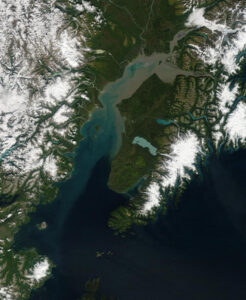Oil-Suspended Particulate Matter Aggregates (OSA)
As shown in the satellite image on the right, much of Cook Inlet has significant suspended sediment loads in the upper water column due to high volumes of glacial silt introduced by upper Inlet rivers such as the Matanuska, Susitna, Knik, and Beluga rivers. During an oil spill, natural processes can disperse a portion of the oil into the water column where the oil droplets react with suspended particulate matter (SPM) to create oil-SPM aggregates (OSA). Thus, SPM has the potential to enhance natural dispersion of oil spilled where SPM is high, such as in coastal areas. The formation, transport, and fate of OSAs had not been studied sufficiently for chemically-dispersed oil which left gaps in information needed by decision makers and for incorporation into transport and fate models.
Cook Inlet RCAC had the opportunity to expand a study designed to look at OSA formation in the laboratory by providing sediments and oil that are applicable to our Cook Inlet concerns.
A range of sediments, oils, dispersants, and environmental factors were incorporated in the study led by Dr. Ali Khelifa of Environmental Canada’s Environmental Science & Technology Centre in Ottawa, Ontario. A major goal of the study was to provide information about factors controlling formation and fate of both physically and chemically-dispersed oil droplets in nearshore areas.
Dr. Khelifa’s final study report, appendices, and a presentation given to the Coastal Response Research Center (CRRC), the funding entity, can be found at the following links:
A subsequent report by other researchers at Fisheries and Oceans Canada’s Bedford Institute of Oceanography Centre for Offshore Oil, Gas and Energy Research (COOGER) in Dartmouth, Nova Scotia, used Dr. Kehlifa’s data and Cook Inlet scenarios to develop case studies looking at the transport, fate, and potential risks of OMAs using hydrodynamic and risk assessment models. Their report can be found here »
Participation on National Dispersants Working Group (DWG)
Cook Inlet RCAC Director of Science and Research, Susan Saupe, was asked to participate on a national dispersant working group that was being developed through the Coastal Response Research Center (CRRC). CRRC was established in 2004 as a partnership between the National Oceanic Atmospheric Administration (NOAA), through the Office of Response and Restoration (OR&R), and the University of New Hampshire (UNH).
The Dispersant Working Group (DWG) was originally formed to address data gaps raised in the National Research Council book Understanding Oil Spill Dispersants: Efficacy and Effects, published by the National Academies Press. This book was a detailed effort to compile existing knowledge about dispersants and identify data gaps. Ms. Saupe had been asked to anonymously (at the time) review the report and the CRRC staff believed that input from the RCACs would continue to be beneficial by having RCAC participation on the workgroup that was tasked with prioritizing research needs.
Through a series of working meetings, CRRC funded various research studies that were published and presented to the working group. CRRC provides links to the working group list of participants, as well as workgroup meeting and research documents.
After the unprecedented surface and subsurface use of chemical dispersants during the Deepwater Horizon oil spill, NOAA commissioned an initiative to evaluate the large body of information collected in order to improve decision-making in future spills. A key component of that initiative was to identify key information gaps and develop a research plan to address these gaps. This closely matched with the goals of CRRC’s DWG, so a partnership was formed to develop a dispersants project that included:
- Information Synthesis
- Detailed and Independent Chemical Analysis and Characterization of COREXIT Products
- Interagency Representatives, Academic Scientists, Responders, and Stakeholders Focused Workshop
- Synthesis of Research and Development Needs and Recommendations
- Develop and Implement Dispersant Research Plan
The following white-paper topics provided the framework for the information synthesis and workshop:
- Dispersant Efficacy and Effectiveness
- Degradation of Dispersants and Dispersed Oil
- Physical Transport/Chemical Behavior of Dispersed Oil
- Biological Effects of Dispersants on Surface and Deep Ocean Species
- Dispersants and Seafood Safety
- Dispersants and Human Heath
- Dispersants and Risk Communication and Public/Media/Political Perspectives
Cook Inlet RCAC again participated in this initiative. In 2012, the project report titled The Future of Dispersant Use in Oil Spill Response was released.
Although Cook Inlet RCAC has taken the formal position that In Situ Burning should be a preferred response option in mobile, winter ice conditions in upper and central Cook Inlet, we recognize that in addition to mechanical containment, the decision-makers have the option of applying dispersants in Alaska. Staff participates with the Alaska Regional Response Team’s Dispersant Working Group charged with reviewing the Dispersant Plan for Alaska. This proposed plan would replace the existing Dispersant Use Guidelines for Alaska. Cook Inlet RCAC reviewed the document and submitted comments to the ARRT. On January 27, 2016, the ARRT approved the new dispersant guidelines for Alaska.
With recent increased interest in expanding offshore oil and gas development and transportation in the Arctic, there has also been renewed interest in increasing our understanding of dispersant efficacy, effects, fate, and transport in the Arctic. One goal is to improve data on dispersants likely used in Alaska using realistic Arctic environmental conditions (e.g. cold water conditions, variable salinities, toxicity tests using local species or representative species, etc…). There are numerous efforts under way and a good source of recent literature and data is at the Prince William Sound RCAC dispersant literature review and database website.
A recent report by the Government Accountability Office released in May 2012, titled Oil Dispersants: Additional Research Needed, Particularly on Subsurface and Arctic Applications was provided to Congress to help focus research efforts for the Arctic.











